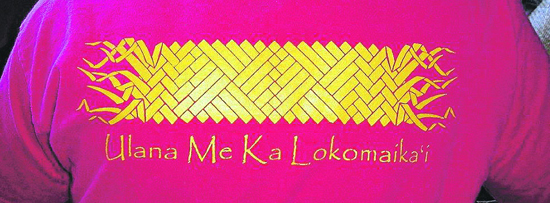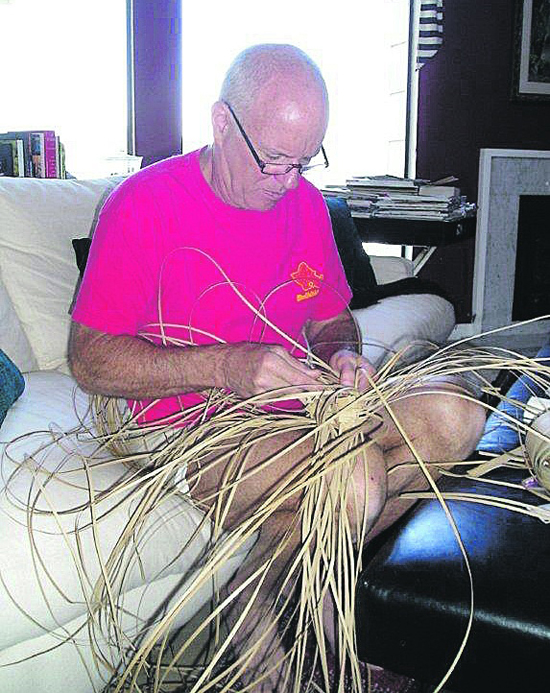| | Published August 17th, 2011
| Making Papale
| | Cathy Dausman |  | |
|
Michael Edwards may live in Lamorinda, but his heart and his hands are in Hawaii. Edwards makes Lauhala hats, woven from the dried leaves of the Lauhala trees. It's a skill he learned four years ago on the islands from "Auntie" Gladys Grace, a 90-year old Hawaiian honored in 2010 with an award from the National Endowment for the Arts. "I am connected with Hawaii when I'm doing this," he says.
 Edwards claims he has only been taught the basics, but it's apparent he's a quick study. He even makes his own weaving tools. Hat weaving begins when a student cleans and trims a tree of detritus. He then waits up to two months before harvesting leaves. "You must malana the trees," Edwards explains, as islanders first ask permission of the living tree before harvesting its leaves. Edwards claims he has only been taught the basics, but it's apparent he's a quick study. He even makes his own weaving tools. Hat weaving begins when a student cleans and trims a tree of detritus. He then waits up to two months before harvesting leaves. "You must malana the trees," Edwards explains, as islanders first ask permission of the living tree before harvesting its leaves.
 Other South Pacific Island weaving uses green leaves, but Hawaiian style hat-making requires dried leaves picked brown from the tree. That can be dirty work, as Lauhala trees are home to centipedes and cockroaches. Edwards has learned to wear long sleeves and to keep his mouth closed when picking. Leaves need to be at least three feet in length, and may need to be stripped of any kuku (thorns) before being rolled and packed tightly, stem to tip, in a kuka'a (wheel of leaves). The leaves, which are several inches across, are sliced into strands about ? inch. Kumus (teachers) then show students how to turn rectangular leaf blades into a circular hat. Other South Pacific Island weaving uses green leaves, but Hawaiian style hat-making requires dried leaves picked brown from the tree. That can be dirty work, as Lauhala trees are home to centipedes and cockroaches. Edwards has learned to wear long sleeves and to keep his mouth closed when picking. Leaves need to be at least three feet in length, and may need to be stripped of any kuku (thorns) before being rolled and packed tightly, stem to tip, in a kuka'a (wheel of leaves). The leaves, which are several inches across, are sliced into strands about ? inch. Kumus (teachers) then show students how to turn rectangular leaf blades into a circular hat.
 The start of a Lauhala hat is the piko, or crown. Piko is Hawaiian for origin; sometimes beginners weave piko mats for practice before making hats. Looking at the start of a piko for a Hawaiian papale (hat) is a bit like seeing a hula skirt in a strong wind-loose ends fly everywhere. The leaf "fabric" has both a warp and weft side-known as the ku and moe. The stem side of the leaf always faces center, and the more sun-resistant side of the leaf faces out. The start of a Lauhala hat is the piko, or crown. Piko is Hawaiian for origin; sometimes beginners weave piko mats for practice before making hats. Looking at the start of a piko for a Hawaiian papale (hat) is a bit like seeing a hula skirt in a strong wind-loose ends fly everywhere. The leaf "fabric" has both a warp and weft side-known as the ku and moe. The stem side of the leaf always faces center, and the more sun-resistant side of the leaf faces out.
 The pa, or top, comes next. As the woven piece expands, fill strands are used. The piko and pa are tied onto an ipu (hat block made of wood or plastic) and the body and brim can be woven together. Sounds simple, doesn't it? But be careful not to pull the pukas, or you'll have a hat full of haku haku (holes). The pa, or top, comes next. As the woven piece expands, fill strands are used. The piko and pa are tied onto an ipu (hat block made of wood or plastic) and the body and brim can be woven together. Sounds simple, doesn't it? But be careful not to pull the pukas, or you'll have a hat full of haku haku (holes).
 Edwards works mostly during extended trips to Hawaii, where the humidity keeps the leaves supple and supplies are readily available. His hats (fedora, flat top, or round top) contain 84 to 220 leaf strands and take weeks to complete. As a finishing touch, each is wrapped with a feather or seed lei. Edward's collection of intricate feather leis was made on Oahu by Bert Nakamura. Edwards works mostly during extended trips to Hawaii, where the humidity keeps the leaves supple and supplies are readily available. His hats (fedora, flat top, or round top) contain 84 to 220 leaf strands and take weeks to complete. As a finishing touch, each is wrapped with a feather or seed lei. Edward's collection of intricate feather leis was made on Oahu by Bert Nakamura.
 The market value of a Lauhala hat is around $300, but Edwards is not selling. "I cannot sell my hats," he says simply, although he has given some as gifts. In four years, Edwards has made only eight hats - he still has his first hat and can point out its shortcomings. He takes to heart the Auntie Gladys admonition: "Only weave when you feel good." The market value of a Lauhala hat is around $300, but Edwards is not selling. "I cannot sell my hats," he says simply, although he has given some as gifts. In four years, Edwards has made only eight hats - he still has his first hat and can point out its shortcomings. He takes to heart the Auntie Gladys admonition: "Only weave when you feel good."
 See Auntie Gladys teach Lauhala hat making online at: http://www.youtube.com/watch?v=0riMgjT-qfE See Auntie Gladys teach Lauhala hat making online at: http://www.youtube.com/watch?v=0riMgjT-qfE |
 | | Michael Edwards works on a Lauhala hat Photo Cathy Dausman
|  | |
| | | | | | | | | Advertisement | | |
| | | print story
Before you print this article, please remember that it will remain in our archive for you to visit anytime.
download pdf
(use the pdf document for best printing results!) | | | Comments | | |
| | | | | | | | | | | | | | | | |




